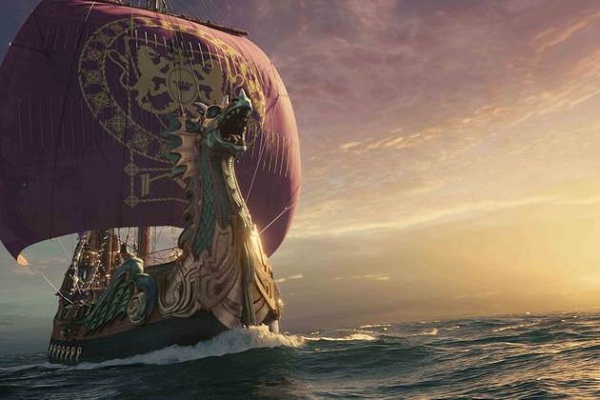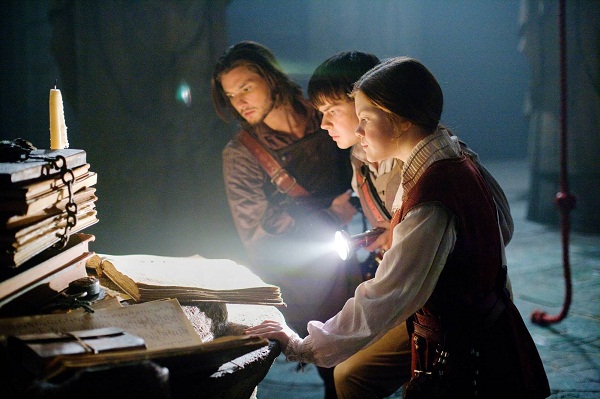The
Chronicles of Narnia: The Voyage of the Dawn Treader
Reviewed by Damien
Straker on December
2, 2010
Twentieth Century Fox presents
a film directed by
Michael Apted
Screenplay by Christopher
Markus, Stephen McFeely
and
Michael Petroni
from the book
"The Voyage of the Dawn Treader" by C.S. Lewis
Starring: Georgie
Henley, Skandar Keynes, Will Poulter, Ben Barnes, Liam Neeson , Simon
Pegg, Tilda Swinton
Running Time: 115 mins
Rating:
PG
Released: December 2,
2010 |
6/10
|
|
Time has passed since
Lucy (Georgie Henley) and Edmund (Skandar Keynes) last ventured into
Narnia. They’re still stuck in England, this time with their nasty
cousin Eustace Scrubb (Will Poulter), while their siblings Peter
(William Moseley) and Susan (Anna Popplewell) have left for America. Out
of nowhere, Lucy, Edmund and Eustace are swept inside the painting of a
ship and sent back to Narnia. They are rescued from the ocean by Caspian
(Ben Barnes), who invites them onboard his sailing ship, the Dawn
Treader. It’s manned by pirates and talking animals, including a large,
sword fighting mouse named Reepicheep (voiced by Simon Pegg). Caspian
describes how Narnia has been at peace for many years now but he insists
on investigating the disappearance of the seven lords. After being
attacked by slave traders and seeing some of their friends disappear
amidst a smoky green spirit, Caspian, Edmund and Lucky must find the
seven swords of the lords to break the curse of Dark Island.

Director Michael Apted
has made a more accessible but less sophisticated adventure film than
the first two in the series (The Lion, The Witch and the Wardrobe
and Prince Caspian, both directed by Andrew Adamson). The
Voyage of the Dawn Treader is lighter both visually and thematically
and, filmed on location in New Zealand and on Australia’s Gold Coast,
spends much of its time on beautiful open waters and coastal villages,
saturated with bright sunlight and gold sandstone. This gives the film a
warmer look and tone but it also lacks the first film’s strikingly cold
and intense colour palette.
But it’s still a
supremely attractive film, and even though the 3D-conversion adds little
more than barely-noticeable depth to some scenes, at least it isn’t as
dim and clunky as the 3D in Clash of the Titans or The Last
Airbender. Interestingly, it’s also a much shorter film than the
other entries, running under two hours and padded with endless panning
aerial shots of the The Dawn Treader itself, the magnificent ship shaped
like the arching back of a sea serpent and powered by an enormous purple
sail.

The most problematic
omission from the film’s narrative are the characters Peter and Susan,
who only appear in a single fantasy sequence (ed – though, to be fair,
they weren’t in the book either). The first Narnia film was strengthened
by not only its religious symbolism but its allegory of family values in
a wartime context. There’s some of that here, especially in the finale,
though the three credited screenwriters seem more interested in the
copious action scenes.
Lucy has grown up
significantly and is therefore more concerned about her looks, wanting
to be more physically like Susan. Edmund also has brief exchanges with
Caspian about who is really leading the ship. These transparent ideas
are driven through uninspired dialogue. Lines such as “to defeat the
darkness out there, you must defeat the darkness inside yourself” might
be true to the novel but do not translate well to screen. Georgie Henley
is at least the sweetest of the children, but there a few fairly
thankless side characters, notably Gary Sweet as a seafaring tough guy
with a pirate growl (When he is asked what’s out in the dark, he just
responds with a snarl: “Pure evil”) The action, of which there is
plenty, is at least dynamic and competently staged. The most elaborate
sequence is a climactic battle involving a giant sea monster which
threatens to crush the ship. Children will probably relish the visual
wizardry in sequences like this, but their parents will be less engaged
by the film’s lack of invention and imagination. |